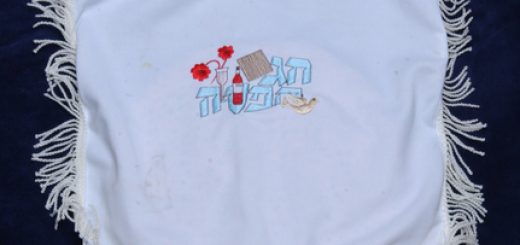A Very Urban Sukkos – A Very Special Sukkos

Sukkos – for many, it’s summer’s last hurrah. Being outdoors, hopefully in green, lush and warm (or not too cold) surroundings. A pleasant return to nature before autumn really kicks in. A great time to spend away from home, perhaps in a rural environment. (Imagine spending Sukkos at a sleepaway camp or a bungalow colony…) Sukkos is the singular Yom Tov when getting out of the city is truly appealing and really seems like a must.
But alas, I have been privileged to spend Sukkos for the past several years in a heavy-duty urban environment – and I would not trade this unique experience for most anything in the world.
For us urbanites, Sukkos means schlepping our food and everything else to a downstairs building courtyard sukkah or a shul sukkah; it means a lack of privacy during meals; it means outside city noise as we eat, learn and even sleep in the sukkah. Who needs it?
On the contrary, the urban Sukkos experience has taught me so much about Sukkos and Yom Tov in general, and it can incredibly enrich our appreciation for the Moed (holiday period) and its important values.
I realize that I have a lot of explaining to do! Here goes:
Contrast
The sukkah reflects the surroundings of divine protection which enveloped our ancestors during their trek forth from Mitzrayim (Egypt) toward the Land of Israel. (V. Gemara Sukkah 11b.) The sukkah also represents the abode of the Shechinah (Divine Presence), which we merit to enter after undergoing the spiritual cleansing of Rosh Hashanah and Yom Kippur. In short, the sukkah is a shelter and sanctuary that provides temporary spiritual respite and recharge from the mundane, bringing us into the realm of the kodesh (holy) for a week.
On a personal level, I feel that this vision is manifest so acutely and truly comes to life when sitting at a Yom Tov meal or in front of a sefer in one of our local urban sukkas. Hearing the world pass by, with the inimitable city cacophony of traffic, sirens, construction noise and so forth, as we are sheltered and immersed in Torah and mitzvos in intimate surroundings of peace and holiness, drives home the message of Sukkos and makes it so palpable! Having a sense of life on an elevated plane in the protective veil of the Shechinah, while the humdrum and at times profane and harsh outside world marches on, is captured so spectacularly through the contrast provided by Sukkos in the city.
Community
Sukkos is a Yom Tov that can in theory be observed in relative isolation, with the exception of shul attendance. Nestled away in a private sukkah, on unshared and possibly remote grounds, an individual or family may be afforded an atmosphere of solitude and seclusion, be it desired or not.
The urban Sukkos is accentuated by a strong feeling of community. Whether one attends communal sukkah meals or one attends private or family sukkah meals in the front or back courtyards of apartment buildings (which often feature clusters of sukkas), the meals are all de facto communal on some level. It is my experience that Sukkos is the one time of the year when I come into contact with neighbors whom I rarely see and with whom I thus almost never interact, as we now find ourselves sitting next to each other at a sukkah meal, or we repeatedly meet and chat in the communal areas in which the sukkahs are located. It is clear from numerous Torah sources that Sukkos is a time of gathering together and achdus (unity); this image is recreated as sensations of camaraderie and community permeate the air of Sukkos in the city.
Sacrifice for Mitzvos
Aggadic and liturgical sources imply that Sukkos is a time for mesiras nefesh/sacrifice for mitzvah performance. Yes, we cherish the experience of dwelling in the sukkah, but it takes commitment, lots of work and often a substantial forfeiture of comfort. In my neighborhood of Washington Heights, despite the fact that K’hal Adath Jeshurun (KAJ – the “Breuer’s” congregation) arranges catered Yom Tov meals in its sukkah (an amazing service, of which we avail ourselves in part), constantly schlepping one’s food, meal accoutrements and self to an apartment building courtyard sukkah or a shul shukkah is laborious and inevitable for all – yet is immensely rewarding and invigorating. Putting forth hard work toward the fulfillment of an enriching and wondrous mitzvah is what it is all about.
Although I attend a few shuls in my neighborhood, I have always been drawn to KAJ in particular for Sukkos. Part of it is practical, for KAJ provides two large communal sukkos, with full-time upkeep and security; it is a marvelous service for the entire community. And part of it is out of appreciation for the beauty and uniqueness of the KAJ Sukkos tefillos (prayer services), which are profoundly inspiring and uplifting.
I would like to briefly highlight a few examples for those who have not been part of this experience.
Sukkos Nusach/Liturgical Melodies
Every Yom Tov at KAJ has its own nusach to which specific tefillos are chanted. There are nuscha’os that were especially commissioned by Rav Samson Raphael Hirsch when he led the original KAJ of Frankfurt, Germany a century and a half ago, and there are nuscha’os that date back to Medieval and even ancient times. All of these nuscha’os are musical motifs which bring forth and dramatize the proper meaning of the prayers.
On Sukkos, an elaborate and distinctive special nusach is used to start the davening (Adon Olam, sung by the chazzan), as well as for the parts of Hallel in which the Arba’ah Minim (Four Species) are waved, for the Chatzi Kaddish (Half Kaddish) following the Torah reading, and for other specific parts of the tefillah. Hoshanos are chanted to a stirring, deep minor key motif, which accents the supplicatory and solemn nature of the Hoshanos liturgy. ‘ממעמקים קראתיך ד – “From the depths have I called to you, Hashem” is the mood that is engendered.
Decorum
Sukkos is the one Yom Tov when things can get messy at shul. Leaves strewn on the floor, Arba’ah Minim left all over the place, hazards of running into others with the point of one’s lulav… At KAJ, this does not happen. The atmosphere of elevated dignity is retained for Sukkos, as is proper at all times for a shul, as a beis Hashem (house of God). This atmosphere of sanctified decorum also prevents the distraction during tefillah that untidy and disorderly surroundings can create.
Preparedness
Despite the festive flavor of Yom Tov and people’s hectic and often unpredictable schedules during Sukkos, davening at KAJ is the hallmark of preparedness. הכון לקראת אלקיך ישראל – “Prepare to encounter your God, Israel.” Tefillah is never casual: the person who will serve as chazzan for each minyan is designated well in advance, the service is led with utmost dignity and refinement, and the specifically designated nusach for each tefillah must be followed. (No searching for a volunteer as chazzan a few seconds before or after the official time for the service has arrived, at which point someone shrugs his shoulders, agrees to lead davening, and hopes he can remember a few Carlebach tunes that will carry him through the tefillah and will sort of fit into the words.)
Wishing all readers a good Yom Tov/חג שמח.




Nusach, decorum, preparedness: Following on your earlier essay encouraging Neo-Litvaks, these would be among the hallmarks of a Neo-Yekkish approach to davening, which (imho) our communities sorely need.